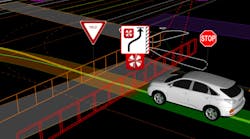For months now, Tesla Motors has grabbed headline after headline for its autonomous car technology. Guess that’s what happens when a company actually delivers early batches of a wildly anticipated model that will incorporate more autonomy than ever. Uber, too, has remained near the top of the conversation, though in large thanks to culture snafus and executive moves. And all the while, older automakers like Ford, Volvo and Fiat Chrysler have at least hung around, never out of sight or of mind.
And then Waymo jumped back in.
In case you forgot, Waymo is Alphabet’s (or, c’mon, Google’s) entry into the autonomous space. The tech giant made some serious noise in September 2015, thanks to hiring former Hyundai CEO John Krafcik to run its self-driving show. Their rather unique looking cars logged loads of miles around its Mountain View headquarters in California the rest of that year and into 2016. Then, in December 2016, news spread that Alphabet planned to scale back the project. And then all of it just sort of … disappeared.
Until last week, that is, when an explosive story from tech writer Adrian Madrigal landed on The Atlantic. Alphabet granted Madrigal the first inside look for any journalist at its proprietary software, called Carcraft. The company also opened just about every door — literal and proverbial — as it jumped out of its latest round of stealth mode like four dozen relatively coordinated guests at a surprise party.
Waymo is back, still on its own schedule, still orchestrating all its own moves and controlling its narrative.
Here, the eight most important facts and biggest surprises from Madrigal and The Atlantic:
1. Cost is no object, of course, for Waymo, which constructed a private city on an old Air Force base near Fresno. The original site was the parking lot across the street from a Bay Area amphitheater, but concerts continued to interfere. “We’d come up with a group of things that we wanted to test, get our supplies in a truck, and drive the truck down to the lot and run the test,” structured testing lead Steph Villegas said. But then, “It was like, ‘Well Metallica is coming, so we’re gonna have to hit the road.’” Inside the old base, nicknamed Castle, Waymo has residential streets, expressway streets, cul-de-sacs … a nice upgrade from just a parking lot.
2. Waymo recorded more than 3 million miles last year on real roads. That sounds impressive — most folks, after all, never crack 1 million in a lifetime on their own — until hearing the company recorded 2.5 billion virtual miles on Carcraft during the same stretch, thanks to as many as 25,000 virtual autonomous cars running at any time. And those are “interesting” miles, too, testing all sorts of strange situations (or just testing the same situation hundreds or thousands of times with hundreds or thousands of variables), not just cruise control on the highway.
3. The engineer who created Carcraft applied through a job post. “I couldn’t believe they just had a job posting up,” said James Stout, a senior staff software engineer who joined Waymo in January 2013, before it was Waymo, after almost four years in a similar position in partner solutions for Google.
4. All that simulation is the biggest key, and it has three core facets: It allows for experience, which is always good; it allows for those interesting interactions, which are far more meaningful than rolling autonomously in cruise control; and it allows for remarkably faster software development cycles.
5. Because the California DMV requires companies to report their annual autonomous miles, we know exactly how many miles Waymo has logged compared to other companies: “It’s driven “three orders of magnitude more miles than anyone else,” Madrigal writes. To be specific, the company logged 635,868 from December 2015 through November 2016, with one disengagement on average about every 5,000 miles. (Improvements over the previous year from 424,331 and one disengagement about every 1,000 miles, respectively.) Everybody else drove, oh, about 20,000 autonomous miles … combined.
6. Waymo is testing Level 4 autonomy, which does not allow for internal driving. No wheel, no pedals, no control. According to Sunil Chintakindi, head of innovation for Allstate Insurance, all those simulated miles really allow for it. “Without a robust simulation infrastructure,” he said, “there is no way you can build (higher levels of autonomy).”
7. As for those more traditional automakers, they’re looking for something different. “GM, Ford, Toyota, and others are saying, ‘Let me reduce the numbers of crashes and fatalities and increase safety for the mass market,’” said Huei Peng, the director of Mcity, the autonomous and connected vehicle lab at the University of Michigan. “Their target is totally different.”
8. Finally, real roads will likely have real drivers for years after Waymo introduces its autonomous cars, so Castle does, too … and those real drivers have a collective name: They are foxes, as in faux, as in fake. In this setting, they are just actors, driving cars, creating traffic — living out some sort of reality.



